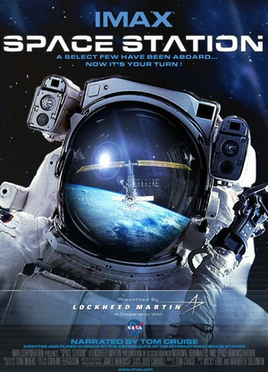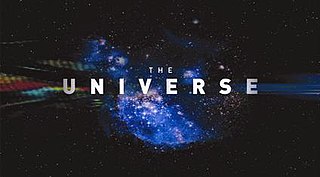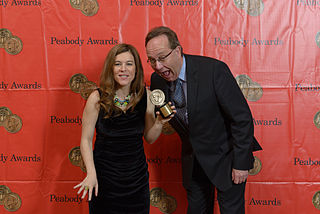
IMAX is a proprietary system of high-resolution cameras, film formats, film projectors, and theaters known for having very large screens with a tall aspect ratio and steep stadium seating, with the 1.43:1 ratio format being available only in few selected locations.
The Electric Image Animation System (EIAS) is a 3D computer graphics package published by EIAS3D. It currently runs on the macOS and Windows platforms.

Stereoscopy is a technique for creating or enhancing the illusion of depth in an image by means of stereopsis for binocular vision. The word stereoscopy derives from Greek στερεός (stereos) 'firm, solid', and σκοπέω (skopeō) 'to look, to see'. Any stereoscopic image is called a stereogram. Originally, stereogram referred to a pair of stereo images which could be viewed using a stereoscope.
3D films are motion pictures made to give an illusion of three-dimensional solidity, usually with the help of special glasses worn by viewers. They have existed in some form since 1915, but had been largely relegated to a niche in the motion picture industry because of the costly hardware and processes required to produce and display a 3D film, and the lack of a standardized format for all segments of the entertainment business. Nonetheless, 3D films were prominently featured in the 1950s in American cinema, and later experienced a worldwide resurgence in the 1980s and 1990s driven by IMAX high-end theaters and Disney-themed venues. 3D films became increasingly successful throughout the 2000s, peaking with the success of 3D presentations of Avatar in December 2009, after which 3D films again decreased in popularity. Certain directors have also taken more experimental approaches to 3D filmmaking, most notably celebrated auteur Jean-Luc Godard in his film Goodbye to Language.

Brian Randolph Greene is an American physicist. Greene was a physics professor at Cornell University from 1990–1995, and has been a professor at Columbia University since 1996 and chairman of the World Science Festival since co-founding it in 2008. Greene has worked on mirror symmetry, relating two different Calabi–Yau manifolds. He also described the flop transition, a mild form of topology change, showing that topology in string theory can change at the conifold point.
The universe is all of time and space and their contents.
Universe is a 1960 black-and-white documentary short film made in 1960 by Roman Kroitor and Colin Low for the National Film Board of Canada (NFB). The NFB writes: "[The film] creates on the screen a vast, awe-inspiring picture of the universe as it would appear to a voyager through space. Realistic animation takes you into far regions of space, beyond the reach of the strongest telescope, past Moon, Sun, and Milky Way into galaxies yet unfathomed."

L'arrivée d'un train en gare de La Ciotat is an 1895 French short silent documentary film directed and produced by Auguste and Louis Lumière. Contrary to myth, it was not shown at the Lumières' first public film screening on 28 December 1895 in Paris, France: the programme of ten films shown that day makes no mention of it. Its first public showing took place in January 1896. It is indexed as Lumière No. 653.

Space Station 3D is a 2002 Canadian-American 3D short documentary film about the International Space Station written, produced, edited and directed by Toni Myers. Narrated by Tom Cruise, it is the first IMAX 3D production filmed in space.

A nature documentary or wildlife documentary is a genre of documentary film or series about animals, plants, or other non-human living creatures. Nature documentaries usually concentrate on video taken in the subject's natural habitat, but often including footage of trained and captive animals, too. Sometimes they are about wildlife or ecosystems in relationship to human beings. Such programmes are most frequently made for television, particularly for public broadcasting channels, but some are also made for the cinema. The proliferation of this genre occurred almost simultaneously alongside the production of similar television series which is distributed across the world.
Cosmic View: The Universe in 40 Jumps is a 1957 book by Dutch educator Kees Boeke that combines writing and graphics to explore many levels of size and structure, from the astronomically vast to the atomically tiny. The book begins with a photograph of a Dutch girl sitting outside a school and holding a cat. The text backs up from the original photo, with graphics that include more and more of the vast reaches of space in which the girl is located. It then narrows in on the original picture, with graphics that show ever smaller areas until the nucleus of a sodium atom is reached. Boeke writes commentary on each graphic, along with introductory and concluding notes.

The Universe is an American documentary television series that features computer-generated imagery and computer graphics of astronomical objects in the universe plus interviews with experts who study in the fields of cosmology, astronomy, and astrophysics. The program is produced by Flight 33 Productions and Workaholic Productions.

WorldWide Telescope (WWT) is an open-source set of applications, data and cloud services, originally created by Microsoft Research but now an open source project hosted on GitHub. The .NET Foundation holds the copyright and the project is managed by the American Astronomical Society and has been supported by grants from the Moore Foundation and National Science Foundation. WWT displays astronomical, earth and planetary data allowing visual navigation through the 3-dimensional (3D) Universe. Users are able to navigate the sky by panning and zooming, or explore the 3D universe from the surface of Earth to past the Cosmic microwave background (CMB), viewing both visual imagery and scientific data about that area and the objects in it. Data is curated from hundreds of different data sources, but its open data nature allows users to explore any third party data that conforms to a WWT supported format. With the rich source of multi-spectral all-sky images it is possible to view the sky in many wavelengths of light. The software utilizes Microsoft's Visual Experience Engine technologies to function. WWT can also be used to visualize arbitrary or abstract data sets and time series data.
The animated documentary is a moving image form that combines animation and documentary. This form should not be confused with documentaries about movie and TV animation history that feature excerpts.

Hubble is a 2010 American documentary film about Space Shuttle missions to repair and upgrade the Hubble Space Telescope. It is narrated by the actor Leonardo DiCaprio.

Euclid is a wide-angle space telescope with a 600-megapixel camera to record visible light, a near-infrared spectrometer, and photometer, to determine the redshift of detected galaxies. It was developed by the European Space Agency (ESA) and the Euclid Consortium and was launched on 1 July 2023 from Cape Canaveral in Florida.

Katerina Cizek is a Canadian documentary director and a pioneer in digital documentaries. She is the Artistic Director, Co-Founder and Executive Producer of the Co-Creation Studio at MIT Open Documentary Lab.

Highrise is a multi-year, multimedia documentary project about life in residential highrises, directed by Katerina Cizek and produced by Gerry Flahive for the National Film Board of Canada (NFB). The project, which began in 2009, includes five web documentaries—The Thousandth Tower, Out My Window, One Millionth Tower, A Short History of the Highrise and Universe Within: Digital Lives in the Global Highrise—as well as more than 20 derivative projects such as public art exhibits and live performances.

Sequart Organization is an online magazine that focuses on the study of popular culture and the promotion of comic books as an art form. Sequart also publishes books and produces documentary films. It was founded in 1996 by Julian Darius. Sequart's editor-in-chief is Mike Phillips.
Hidden universe or variation, may refer to:













